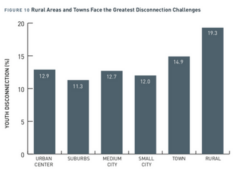
[note: this archive page describes the early success of the OY Movement, from 2012-2018]
Measure of America’s 2018 report More Than A Million Reasons For Hope announced that the numbers of opportunity youth has decreased from 5.8 million to 4.6 million during the period of 2012-2016. During this time more than 1 million youth ages 16-24 were reconnected to education and jobs.
In addition to this success, there has been an increase in awareness of the needs of opportunity youth in communities across the country. The increased awareness corresponds with a shift to an asset-based narrative about opportunity youth, in which young people are seen as resources rather than problems to be solved. At the same time, communities have experienced an increased federal investment of initiatives that help connect opportunity youth to employment and education pathways; increased private sector backing in jobs and career trainings, and bolstered local funding streams.


[charts from Measure of America’s 2018 report More Than A Million Reasons For Hope]
While the total opportunity youth number is still unacceptably high, our early years show that progress can happen - a steady decline occurred in the first 6 years or work: a 20 percent overall reduction in the numbers.
This OYN yearbook, which was released at the OYN 2017 Annual Summit, tracks the impact the Opportunity Youth Network (a coalition of more than three dozen non-profit, government and corporate organizations) has made this past year, as well as its plans and growth for 2018.
For example the Alliance for Boys and Men of Color supported partners who worked to help pass significant California state legislation that addresses in-school suspensions, undocumented students, non-discriminatory admissions and suspension policies at charter schools and housing assistance, among others. The yearbook also details the Forum for Community Solutions’ new strategic planning process that transitioned the Opportunity Youth Incentive Fund to the Opportunity Youth Forum.
Other highlights:
- Grads of life released a new PSA campaign in collaboration with the Ad Council and received $90 million in donated media
- Goodwill is joining with Google to expand digital skills training and credentialing through local Goodwill organizations
- The iFoster Jobs Program was selected for formal evaluation by the U.S. Department for Health and Human Services Administration for Children and Families as a promising program for foster youth employment
- The Center for Native American Youth at the Aspen Institute is expanding the Generation Indigenous National Native Youth Network, which was launched by President Barack Obama
- The Forum for Community Solutions and Jobs for the Future hosted the successful the Opportunity Youth Forum Spring 2018 Convening in South King County, WA from May 14-17
To read additional highlights on the progress to date, please visit here.
In spite of all the progress to date, more change is necessary to ensure some groups of opportunity youth that continue to experience disproportionately higher rates of disconnection, achieve better outcomes. Young people — particularly young men of color, youth living in poverty or with a disability, and young mothers — are all far more likely to be disconnected than their peers. As Measure of America reports, “There is a chasm of nearly 20 percentage points in disconnection rates separating racial and ethnic groups. Asian youth have the lowest rate of disconnection (6.6 percent), followed by white (9.2 percent), Latino (13.7 percent), black (17.2 percent), and lastly, Native American (25.8 percent) youth. Youth disconnection has decreased over time for all major racial and ethnic groups; however, the gap between the groups with the highest and lowest rates has not narrowed appreciably.”
The report shows the power and importance of disaggregating data – and goes further than just looking at race alone. For example, it looks at groups within the Asian group, and finds a 10 percentage point difference between some subgroups.
Additional demographic data reported includes:
- Disconnected young women are nearly four times as likely to have a child as connected young women.
- Disconnected young people are more than three times as likely to have a disability as connected young people.
- A very small percentage of connected youth are institutionalized, just 0.3 percent. The rate for disconnected youth is twenty-two times higher.
Across the country, 38 states experienced a significant improvement. Unfortunately, rural areas continue to struggle the most with youth disconnection, experiencing significantly higher rates than other community types.